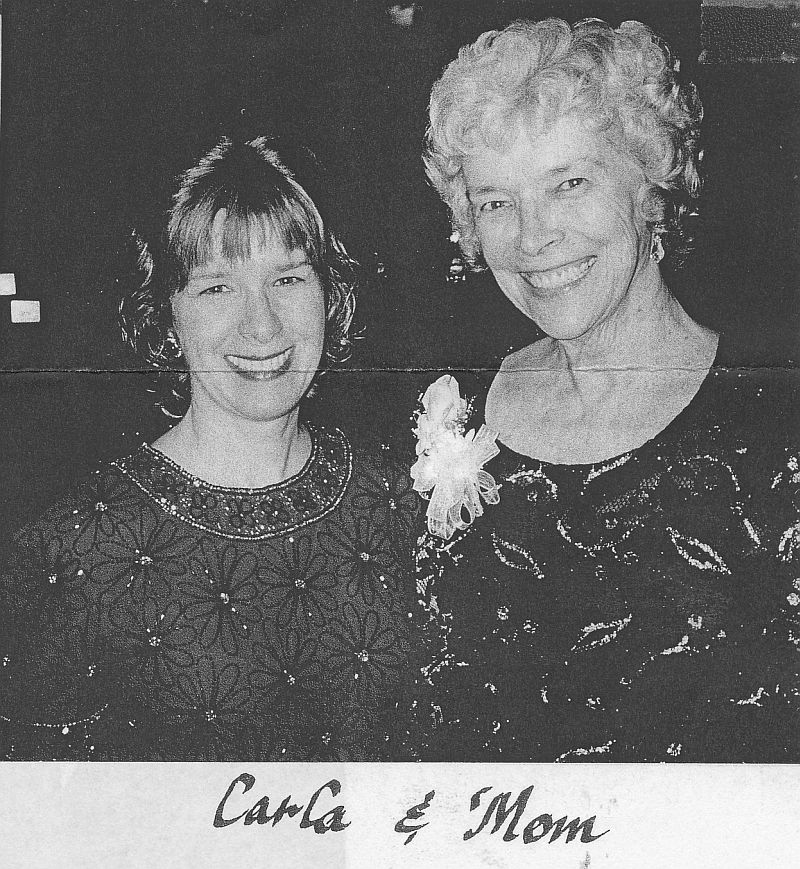 I learned Sunday Morning, June 24ththat my friend and mentor Manon Washburn had passed away as the result of a stroke the previous week (June 21st). Manon’s daughter Carla told me the news, above is a recent picture of Mother and Daughter from 2010.
I learned Sunday Morning, June 24ththat my friend and mentor Manon Washburn had passed away as the result of a stroke the previous week (June 21st). Manon’s daughter Carla told me the news, above is a recent picture of Mother and Daughter from 2010.
(In honor of Manon, no comics this post, all the cartoons are illustrations for the article. I have preserved most of Manon’s spelling and punctuation in the excerpts from her letters. Remember to click on the thumbnails to enlarge the pictures.)
You see, Manon was a very special childhood heroine of mine. Her first husband, Everett Washburn was a sheet metal worker who was employed at Curtis-Wright aircraft in California with my Dad Albert in the 1930s. Dad thought a great deal of Everett, they were good friends, and Everett told my dad that his wife was an inker in the animated cartoon business. I wrote to her, telling her of my great love for cartoons and desire to get into the business. Amazingly, she was not discouraging, but decidedly upbeat about it, a great contrast to my Mother’s attitude toward cartoons. We exchanged letters often, and she sent me many inked cels from commercials and TV shows she was working on, this was 1963 to 1967. She went out of her way to find animation artwork for me: Manon writing on March 12, 1964: I am really thrilled with one thing I am sending and am so very lucky to have gotten it. It is a complete story-board layout of one of the half-hour Flintstone shows. (TS-132 “Ladies Night Out At The Lodge”P-109) You yourself are really responsible for my getting it. You see, I have patiently approached one animator after another with your letter and begged for a crumb from their board. Some, as you know, are too busy to take much interest, others are pleased at your interest but don’t come up with anything—-and then there’s that one in a million who really knocks himself out because he has the capacity to appreciate what you are doing. This one I am talking about is an animator, a marvelous one, named Willie Ito (pronounced EETO). He is of Japanese descent I think but a real “way out kid” and what an artist! Well, anyhow, I told Willie about you (he works at Hanna-Barbera) and gave him your letter to read at his leasuire. He was charming and appeared both interested and impressed but I wasn’t sure about it until he handed me a huge folder full of loot!! He enclosed all kinds of production pictures beside the layout but told me he was sure you would get the most out of it because all the camera instructions are given on it and you would see all the terms that they use and how they indicate various things. I went through it carefully and was tempted to interpret such things as FX which means effects (sound, usually) but decided against it because I’m pretty sure you will understand it all without my help. I feel that you have enough background in animation to figure it out without difficulty. Of course, it goes without saying, that someone without your knowledge would not get the camera moves indicated and other strictly animation terms. (Among the drawings were several from the Magilla Gorilla Show main titles)
You yourself are really responsible for my getting it. You see, I have patiently approached one animator after another with your letter and begged for a crumb from their board. Some, as you know, are too busy to take much interest, others are pleased at your interest but don’t come up with anything—-and then there’s that one in a million who really knocks himself out because he has the capacity to appreciate what you are doing. This one I am talking about is an animator, a marvelous one, named Willie Ito (pronounced EETO). He is of Japanese descent I think but a real “way out kid” and what an artist! Well, anyhow, I told Willie about you (he works at Hanna-Barbera) and gave him your letter to read at his leasuire. He was charming and appeared both interested and impressed but I wasn’t sure about it until he handed me a huge folder full of loot!! He enclosed all kinds of production pictures beside the layout but told me he was sure you would get the most out of it because all the camera instructions are given on it and you would see all the terms that they use and how they indicate various things. I went through it carefully and was tempted to interpret such things as FX which means effects (sound, usually) but decided against it because I’m pretty sure you will understand it all without my help. I feel that you have enough background in animation to figure it out without difficulty. Of course, it goes without saying, that someone without your knowledge would not get the camera moves indicated and other strictly animation terms. (Among the drawings were several from the Magilla Gorilla Show main titles) 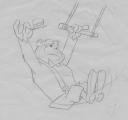 Do let me know if you are as pleased with it as I was. If you saw this particular Flintstone show, it will have even more meaning than otherwise. I always admired her ability with pen and brush on the unforgiving plastic ice pond known as a cel. She had such a delicate, supple fine line. Look at these examples from a Navy Recruiting spot produced at Playhouse Pictures.
Do let me know if you are as pleased with it as I was. If you saw this particular Flintstone show, it will have even more meaning than otherwise. I always admired her ability with pen and brush on the unforgiving plastic ice pond known as a cel. She had such a delicate, supple fine line. Look at these examples from a Navy Recruiting spot produced at Playhouse Pictures. 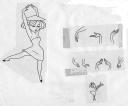 I especially like the hands and the cel with the tiny girl: On a visit to her house in 1963, she showed me several old cels from Leon Schlesinger cartoons of 1943. I remember she had one of Bugs Bunny, an early Elmer Fudd, and several others, all in that amazing fine line. She worked on “Hell-Bent For Election” at the fledgling UPA in 1944 when it was Industrial Film and Poster Service. This pro-Roosevelt film was right in line with her politics at the time. Manon worked on this picture with Martha Sigall, famed Schlesinger inker. Manon writing in 1964: It interested me very much when you said that the “great classics and animation were meant for each other”. I have always felt very strongly that as an educational medium, animation would have no equal. During the war (WWII), I worked on training films for the Army Air Force and I have never been able to forget the wonderful way animation can teach. (This was when Manon was with the First Motion Picture Unit in 1943. She’s to the extreme right of the photo-not politically.)
I especially like the hands and the cel with the tiny girl: On a visit to her house in 1963, she showed me several old cels from Leon Schlesinger cartoons of 1943. I remember she had one of Bugs Bunny, an early Elmer Fudd, and several others, all in that amazing fine line. She worked on “Hell-Bent For Election” at the fledgling UPA in 1944 when it was Industrial Film and Poster Service. This pro-Roosevelt film was right in line with her politics at the time. Manon worked on this picture with Martha Sigall, famed Schlesinger inker. Manon writing in 1964: It interested me very much when you said that the “great classics and animation were meant for each other”. I have always felt very strongly that as an educational medium, animation would have no equal. During the war (WWII), I worked on training films for the Army Air Force and I have never been able to forget the wonderful way animation can teach. (This was when Manon was with the First Motion Picture Unit in 1943. She’s to the extreme right of the photo-not politically.) A year or so ago, there was an hour long animated story on the sun on T.V. (“Our Mr. Sun”) It may have been made for a science class. It was expertly done and the (sometimes) dull scientific facts about the sun, its energy and what relation and effect it has on our lives was never more interestingly given. Here’s a few words about animation that Manon wrote in 1962, together with a wage breakdown for animation workers of the day:
A year or so ago, there was an hour long animated story on the sun on T.V. (“Our Mr. Sun”) It may have been made for a science class. It was expertly done and the (sometimes) dull scientific facts about the sun, its energy and what relation and effect it has on our lives was never more interestingly given. Here’s a few words about animation that Manon wrote in 1962, together with a wage breakdown for animation workers of the day:
One of the most intriguing things about animation is the liberty the animator has in interpreting a character (such as Walt Disney did with Mickey Mouse).I work on all the Burgie Beer commercials–he’s a very stylized little man. There’s a tremendous latitude between a drawing that almost is human and one that’s vastly simplified such as the Folger Coffee bean. I see no harm in Mark concentrating on what interests him most, that is animating a figure. There will always be artists who are only interested in drawing backgrounds. Most of the top people in the animation field have had four years of art school—not as many have had college art training because it usually isn’t as good. U.C.L.A. is, and there he would get the well-rounded education that is necessary in almost every intelligent field today. The top animators become storyboard layout men and for that you need a comprehensive education, psychology, philosophy, history, etc.
I see no harm in Mark concentrating on what interests him most, that is animating a figure. There will always be artists who are only interested in drawing backgrounds. Most of the top people in the animation field have had four years of art school—not as many have had college art training because it usually isn’t as good. U.C.L.A. is, and there he would get the well-rounded education that is necessary in almost every intelligent field today. The top animators become storyboard layout men and for that you need a comprehensive education, psychology, philosophy, history, etc.
The animation field is not too crowded. Highest in demand are the story-board and layout men. Each studio has only a few. Their weekly check is in the neighborhood of $500 a week. The top animators and background artists get between $250 (min.) and $450–etc. Assistant animators (just off the art school assembly line–) begin at $200 a week. Anim. Checkers make $150. Inkers, like myself, make $105. (take home $86) and painters make $90.
Despite the relatively low wages she earned, Manon was a hard worker and often took on two or three jobs at the same time to earn extra money.
Manon writing in August 1967: The Cartoon industry is still flourishing out here! Inkers are still at a premium. For almost two years now. I have been able to make more than a fourty hour check by simply taking work from more than one studio. Everything is still on the up-swing. New contracts and commercials, new animated series are all still very much with us. After I finished Charlie Brown All Stars for Bill Melendez, I went to work for Grant-Ray Lawrence who are putting out a series called Marvel Super Hero’s and out here it is on Sun. eves at 6pm for half an hour. It is limited animation and inking is just a matter of mouths, eyes, arms moving and loads of special effects! (guns blasting-rays-explosions, bullets conecting-etc.–it’s wild!)
Just last week, I also got some work from my favorite employer, Mary Cain, who you met. Disney is so busy with live action and other things–that he farmed out a commercial to Mary—So at last! I can say I have worked for Disney! I was careful to ink several of the cutest characters for you and I will paint them up and send them along! And you can say that Disney had to get his old animators to draw them, as the youngsters didn’t know how! It’s the real thing! Revived!
She did this overtime and free-lance practically all through her working life. Here, Manon gave me an idea of just how busy she could get: …my studio kept me very busy all through December. You should see me inking at my desk while the (neighbor’s) children build with the blocks on the rug beside me. If one knocks the other over the head with a block, Cathy (Manon’s daughter) dashes in to referee while I glance over occasionally to make sure blood isn’t flowing freely yet! As you can see from these sample cels, Manon could work with a wide variety of line styles, thick, thin, brush, pen or grease pencil.



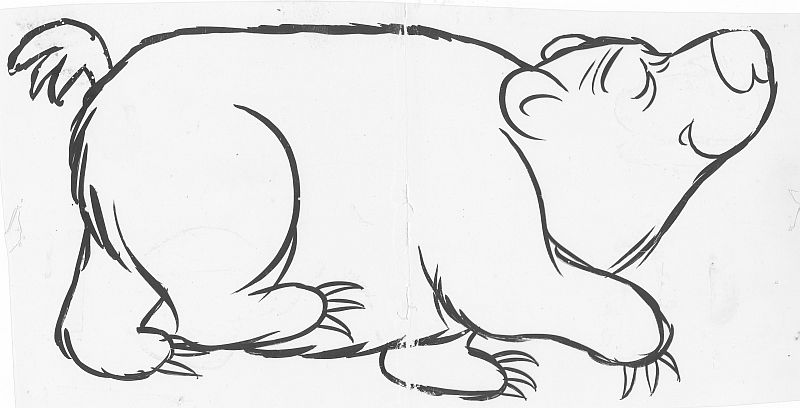 In 1966, Manon sent me a number of long Cinerama sized cels from the title sequence to “It’s a Mad, Mad, Mad, Mad World” which she traced onto the slippery plastic slopes with a grease pencil:
In 1966, Manon sent me a number of long Cinerama sized cels from the title sequence to “It’s a Mad, Mad, Mad, Mad World” which she traced onto the slippery plastic slopes with a grease pencil:
….I am sending some long cels in hopes you can cut them to size. They were rejections on “Mad, Mad World” because of scratches. I don’t think scratches show up on ordinary pictures, it was just that each cel was blown up ten feet and every speck of dust came through on the film. Also, I am sending some actual rejected sequences on “Mad World”. This is somewhat against my better judgement because you may find it worthless. I had to do the scene completely over because of scratches and I thought that either you would be interested in seeing the animation or that you could wash the cels off and re-use them. Let me know later on if you found any use for them. I’m still using them, Manon:

I visited the Washburns on my own in the summer of 1968, on vacation from Art School in Kansas City, intending to stay for two weeks. By the time I got out to Los Angeles, Everett and Manon were no longer married, but Everett lived about four blocks away from where Manon lived in Tujunga, so he put me up in a shed at the back of his house. I’ll never forget the first few nights I tried to sleep out there, so excited about cartoons and being so near to where they are made that I couldn’t close my eyes! While staying at Everett’s house, he taught me about Karl Marx and especially Marx’s predecessor, Georg Hegel. Everett was quite a serious, scholarly man who had very deep political beliefs. I got the feeling that Manon and Everett might have been attracted to each other partially from their political sensibilities. Manon could be a firebrand, being quite a critic of the war in Vietnam. She was in great favor of peace, we had quite a few discussions about that.
Manon made it possible for me to have a job, then a career in animated cartooning! She introduced me to Gary Mooney, who was animating a Green Giant commercial at Quartet Studio. He let me do a few inbetweens of the elves in the spot. They were no great beauties, but they were inkable. Here’s one of Gary’s roughs from that spot: I took the drawings into Filmation as samples; Hal Sutherland looked them over and said two words: “Start Monday”. I couldn’t drive, so I learned the bus route from Tujunga (where Manon lived) to Sherman Way in Reseda where Filmation was. I was in cartoon heaven working there, and met many old timers like Ruben Timmens and Virgil Ross. At last I wore out my welcome at Everett’s house (didn’t know enough about Hegel), and wound up bunking in the editing room of Fred Calvert’s studio in North Hollywood, which was a shorter bus ride to Filmation. I found myself working days at Filmation and nights at Fred Calvert’s, to earn my room. I would have worked 24 hours a day if I hadn’t needed sleep, I was just so excited to be doing professional work! I met Duane Crowther at Calvert’s, who became another mentor and great friend to me. All this happened because Manon introduced me to Gary Mooney.
I took the drawings into Filmation as samples; Hal Sutherland looked them over and said two words: “Start Monday”. I couldn’t drive, so I learned the bus route from Tujunga (where Manon lived) to Sherman Way in Reseda where Filmation was. I was in cartoon heaven working there, and met many old timers like Ruben Timmens and Virgil Ross. At last I wore out my welcome at Everett’s house (didn’t know enough about Hegel), and wound up bunking in the editing room of Fred Calvert’s studio in North Hollywood, which was a shorter bus ride to Filmation. I found myself working days at Filmation and nights at Fred Calvert’s, to earn my room. I would have worked 24 hours a day if I hadn’t needed sleep, I was just so excited to be doing professional work! I met Duane Crowther at Calvert’s, who became another mentor and great friend to me. All this happened because Manon introduced me to Gary Mooney.
I remember getting a lot of life lessons from Manon. I was pretty annoying and geeky when I got out to Los Angeles, (still am occasionally) and talked about cartoons almost all the time. Manon put up with it for quite awhile, but she eventually lost patience with my cartoon yammering. She let me know that even though she had been in the business since 1943, she didn’t really care for cartoons all that much. She was an artist, that happened to have the skill to work as an inker. She enjoyed the work to an extent, but it wasn’t a calling. (Later on, Manon taught watercolor painting, just look at her flowers and landscapes.) 
 I don’t think Manon ever told me exactly how she got started in the business, she was probably close to 21 when she started working. She also taught me to respect her as a lady, to open doors for her, and treat her gently. Not that I was rough on her, but I guess I thought of Manon as a fellow cartoon geek. I got wised up eventually.
I don’t think Manon ever told me exactly how she got started in the business, she was probably close to 21 when she started working. She also taught me to respect her as a lady, to open doors for her, and treat her gently. Not that I was rough on her, but I guess I thought of Manon as a fellow cartoon geek. I got wised up eventually.
Some years later, about 1972, I picked up a job from my friend Joe Adamson. He needed an animator to do a few scenes of Bugs Bunny for his independent short film, “A Political Cartoon”. I actually got a few lessons on how to draw Bugs from his best designer, Bob McKimson. When the drawings were finished, I immediately thought of Manon, who agreed to ink them. What a thrill to have an actual Warner Bros. inker doing my rabbits! I paid her as well as I could, and wound up with no money for the background painter, so I did them myself. I tried to save money on paint by using an old jar of Cartoon Colour rewettable white paint, which cracked and chipped in only a few years. This made the cels actually look much older than they actually were. That and Manon’s artistry made them more saleable as collectibles later on.
One of Manon’s good friends at Bill Melendez Studio was Bernard Gruver, a key layout and story board artist. Bernard thought the world of Manon, and often told me that her life stood for love, and she had a loving attitude to just about everybody. Here’s a birthday card that Bernard drew for Manon:
Manon writing on May 15, 1966: Now about things here in Hollywood. Bill Melendez broke with Playhouse Pix and went into business for himself. No, I did not work on the Charlie Brown Christmas Show, but I did see it. And I have worked on the new baseball show which has just gone to camera. It is called “Charlie Brown All Stars”, its about baseball and airs on June 8th. Please see it in color, if you can, you can’t really appreciate it in black and white. (1/2 hour show -full animation)
You will notice that the smaller studios (like Bill’s) always use inkers because on a small production the quality is more noticeable and more important. (An inker can interpret a character and impart a certain flavor.) The big studios are the only ones using Xerox that I know of–Disney–to be specific. Hanna Barbera are using a sort of grease pencil which goes faster than pen and is adequate for their multiple productions. I have worked on some Xerox for some pretty terrible (my opinion) low budget stuff. Inkers have to repair and register all Xerox. Without exception, all the commercials and shows which I have worked on have been inked. This year everything I have done has been in color. Animation comes across beautifully on color television and so much is being done in color now. Personally, I feel more full of hope than ever for animation and its marvelous possibilities for education, in spite of the poor material that has used this (our) medium thus far. I can’t help believing that not only will someone come along and do marvelous, top quality things in animation, but, that as a medium for education it will be fully utilized. Just because Disney has done so much with animation doesn’t mean he has exhausted the possibilities. (It’s interesting that color television was still such a remarkable novelty in 1966.)
Work is plentiful this year and the future looks bright.
Here are a few words that Manon wrote about the automation of the inking process (Xerox) which still ring true in the computer era: I fully agree with all you said on automation. In some places Xerox is replacing inkers but I cannot possibly imagine how it could replace animators. When that day comes and individual creative effort is eliminated it will be a sad commentary on the human race. Let’s have faith that we will never do that to ourselves. I do think that in many places in the world, people are not as barbaric as they used to be. But our scientific development is still way ahead of our social development. The great animator Grim Natwick came to nearly the same conclusion about scientific and social development when he was thinking about computer animation and electronic gadgets years later.
I had the great honor to speak for Manon in 2005, when she got her Golden Award for a lifetime in animation. Manon’s family, my wife Cathy and I were all there around her table at the Golden Awards banquet.  It was such a great night. It was an honor to see one of the good people, the inkers who never got enough credit for making animation drawings look good on the screen, receive this honor from her peers.
In her last years, I saw Manon less frequently. Her family expanded and she became a great-grandmother. Just look at that happy face with her grand-child Cove in 2011. That’s the way I like to remember Manon, that beaming happiness. All her children have that warm smile, it’s a family trademark. Her son, Conrad certainly has the family smile:
That’s the way I like to remember Manon, that beaming happiness. All her children have that warm smile, it’s a family trademark. Her son, Conrad certainly has the family smile:  I learned to respect Manon’s look of seriousness too, it meant she was thinking, and most of her thoughts were worth listening to. Her voice was breathy when she talked, almost a Marilyn Monroe inflection, but not as caricatured. She made friends easily, and never forgot a friend. Manon, I hope you will never be forgotten by your friends. Carla tells me that her Mom was alert, happy, teaching watercolor, dancing and active right up to the very end. Thanks, dear lady for all that you did for me. And so, Manon, Goodbye.
I learned to respect Manon’s look of seriousness too, it meant she was thinking, and most of her thoughts were worth listening to. Her voice was breathy when she talked, almost a Marilyn Monroe inflection, but not as caricatured. She made friends easily, and never forgot a friend. Manon, I hope you will never be forgotten by your friends. Carla tells me that her Mom was alert, happy, teaching watercolor, dancing and active right up to the very end. Thanks, dear lady for all that you did for me. And so, Manon, Goodbye.
(Any comments on Manon would be welcomed by her family. You can reach them at: yiayia.washburn@gmail.com . You are also welcome to comment here.)
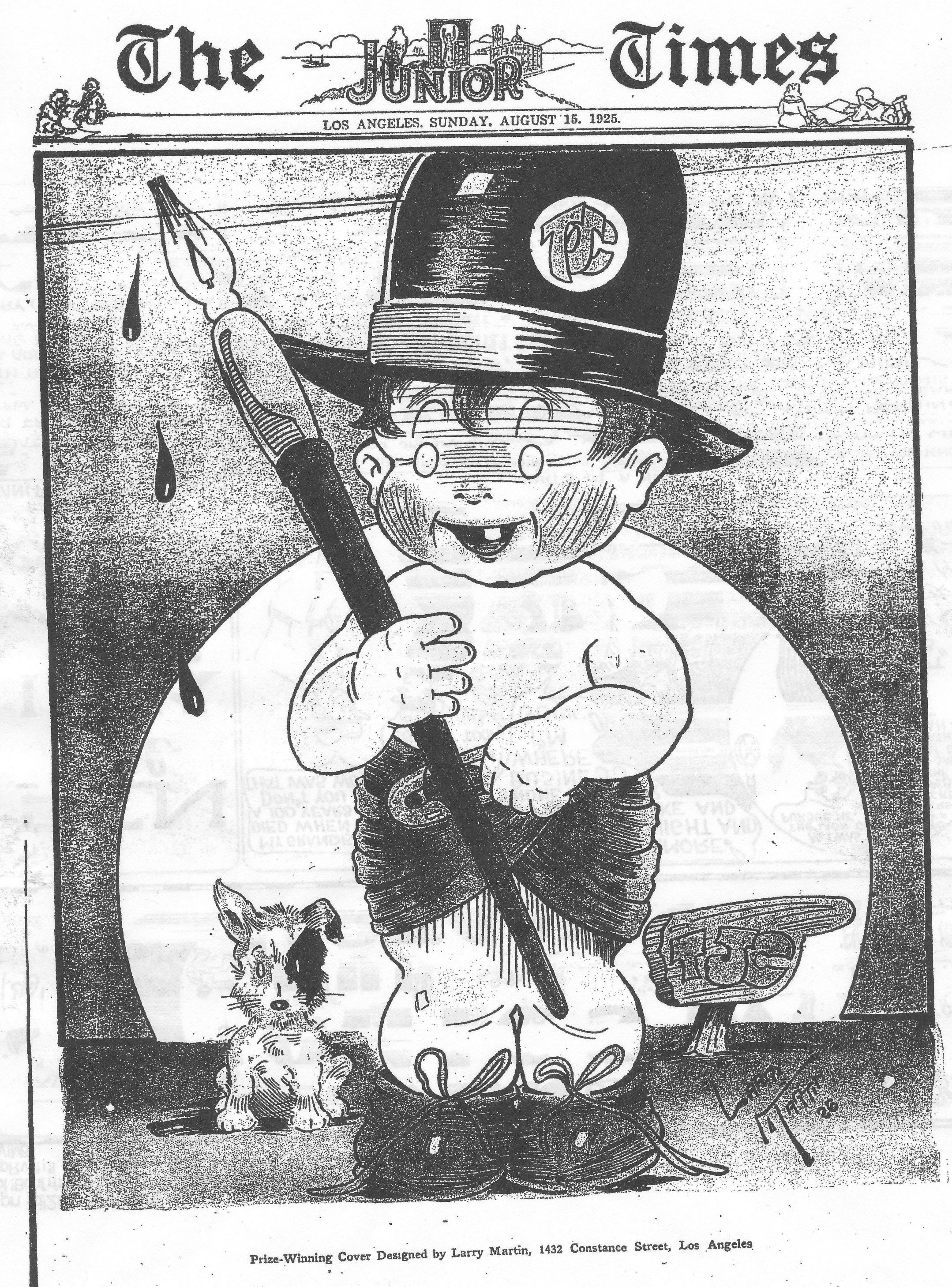
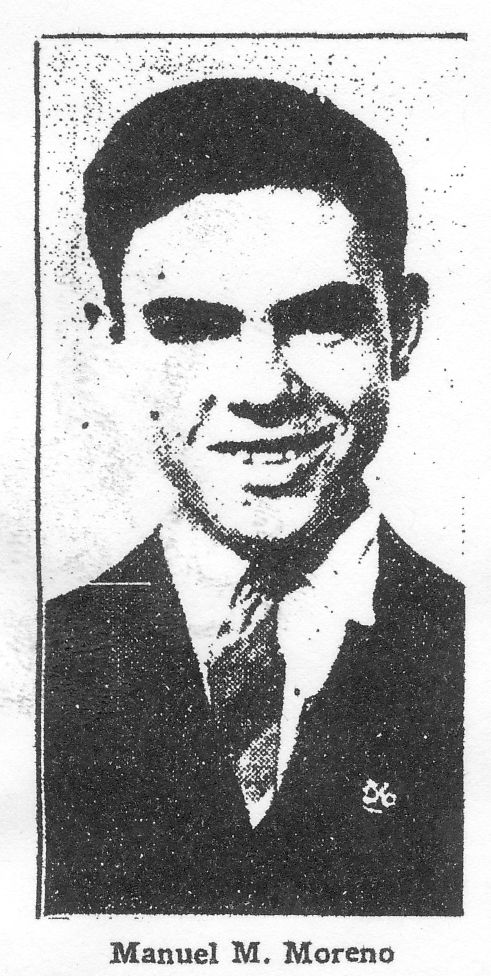 Â Here’s some more of Aunt Dolly’s boy cartoonists of August, 1926! That’s the great Harman-Ising animator Larry Martin’s cover to the 8-15-26 issue of the L.A. Junior Times, and a photo of the future animator, Manuel Moreno, from 8-1-26.
 Here’s some more of Aunt Dolly’s boy cartoonists of August, 1926! That’s the great Harman-Ising animator Larry Martin’s cover to the 8-15-26 issue of the L.A. Junior Times, and a photo of the future animator, Manuel Moreno, from 8-1-26.

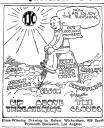
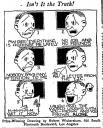
 Â A photograph of the future Thimble Theatre cartoonist, Bela “Bill” Zaboly from 8-8-26 appears above. At this point Bela was living in Cleveland, Ohio and promoting the T.J.C. to the populace with hand-drawn posters. We continue the reprint of Bob Wickersham’s funny animal strip, Fido Bark, from 8-1 to 8-29-26. In the 8-8-26 strip, Fido visits Al Perez’s studio. Al was another Aunt Dolly discovery. A talented cartoonist, Al did comics and decorative work for the Jr. Times. I found two of Wick’s T.J.C. promo cartoons from 8-8 and 8-15-26, which originally appeared on “Aunt Dolly’s Page”. To round it off, the only episode of Manuel Moreno’s “Keen and Feeble Tat” that ran in August is included. By this time, Moreno was already into his professional career, and was drawing fewer strips for the Junior Times. Have any of you readers ever SEEN an actual newspaper copy of the Junior Times? Supposedly, the Boy Cartoonists’s work appeared in color. The pages seem to have been five columns wide.
 A photograph of the future Thimble Theatre cartoonist, Bela “Bill” Zaboly from 8-8-26 appears above. At this point Bela was living in Cleveland, Ohio and promoting the T.J.C. to the populace with hand-drawn posters. We continue the reprint of Bob Wickersham’s funny animal strip, Fido Bark, from 8-1 to 8-29-26. In the 8-8-26 strip, Fido visits Al Perez’s studio. Al was another Aunt Dolly discovery. A talented cartoonist, Al did comics and decorative work for the Jr. Times. I found two of Wick’s T.J.C. promo cartoons from 8-8 and 8-15-26, which originally appeared on “Aunt Dolly’s Page”. To round it off, the only episode of Manuel Moreno’s “Keen and Feeble Tat” that ran in August is included. By this time, Moreno was already into his professional career, and was drawing fewer strips for the Junior Times. Have any of you readers ever SEEN an actual newspaper copy of the Junior Times? Supposedly, the Boy Cartoonists’s work appeared in color. The pages seem to have been five columns wide.






 Â Here’s Barker Bill from 6-13 to 6-23-1955. Newton Mommisboy continues his pursuit of Barker Bill’s Mermaid, only to discover that she’s a fraud! A new story with Puddy starts on 6-22. By this time, I’ve only been able to find 4 out of the 6 dailies for each week. If any one has the missing dailies, please write to me.
 Here’s Barker Bill from 6-13 to 6-23-1955. Newton Mommisboy continues his pursuit of Barker Bill’s Mermaid, only to discover that she’s a fraud! A new story with Puddy starts on 6-22. By this time, I’ve only been able to find 4 out of the 6 dailies for each week. If any one has the missing dailies, please write to me.





 Â Felix is from 8-12 to 8-18-1935, continuing Felix’s hunt for a lost civilization on the Ape’s Island. He goes from a scapegoat in the 8-12, to a hero in the 8-17, when Felix actually digs up an ancient sunken city in the quest for a place to rest! In the Sunday, Felix helps a Jiggs-like man to get out of the house for an evening, if only in his dreams!
 Felix is from 8-12 to 8-18-1935, continuing Felix’s hunt for a lost civilization on the Ape’s Island. He goes from a scapegoat in the 8-12, to a hero in the 8-17, when Felix actually digs up an ancient sunken city in the quest for a place to rest! In the Sunday, Felix helps a Jiggs-like man to get out of the house for an evening, if only in his dreams!




 Â Krazy is from 6-23 to 6-28-1941 this time. Not much continuity, except for 6-26 and 6-27, where Krazy fools a swami mind-reader by thinking in “Eskimo”, sort of forshadowing the use of the Navajo language for code during World War II.
 Krazy is from 6-23 to 6-28-1941 this time. Not much continuity, except for 6-26 and 6-27, where Krazy fools a swami mind-reader by thinking in “Eskimo”, sort of forshadowing the use of the Navajo language for code during World War II.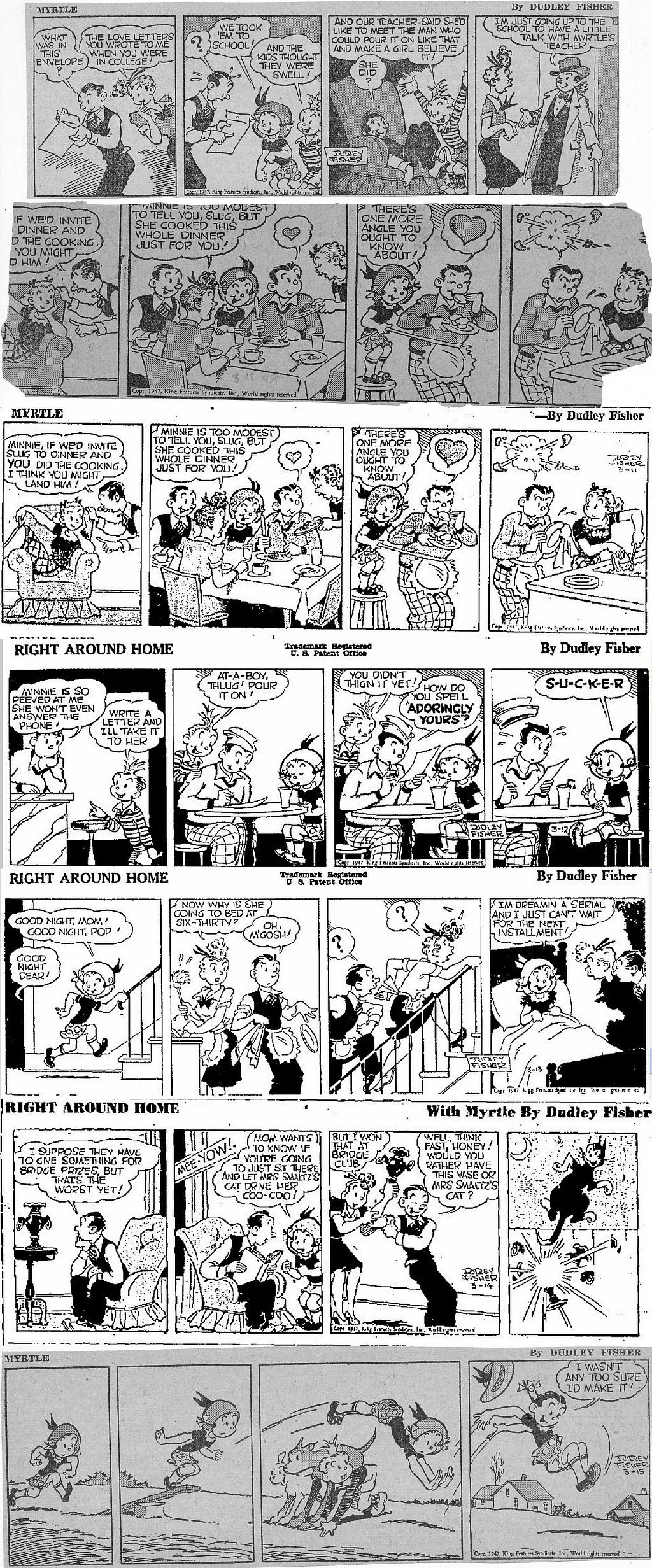  Myrtle is from 3-10 to 3-15-1947 in this batch. My newspaper run was short by 3 1/2 strips, so I found the missing ones over at Newspaper Archive. My favorite Fisher Frolic this time is the 3-15 strip. Note in the third and fourth panel how Fisher links the action as Myrtle tumbles over the dogs and Sampson. The speed lines from Myrtle’s hands overlap the panel border, giving a real feel of continuous animation to her tumbling act. It was my brother’s idea to fill in the missing Myrtle strips, which, despite the variance in quality, I think is a good one. Let me know if any of you have actual Junior Times issues, and we’ll see you again soon.
 Myrtle is from 3-10 to 3-15-1947 in this batch. My newspaper run was short by 3 1/2 strips, so I found the missing ones over at Newspaper Archive. My favorite Fisher Frolic this time is the 3-15 strip. Note in the third and fourth panel how Fisher links the action as Myrtle tumbles over the dogs and Sampson. The speed lines from Myrtle’s hands overlap the panel border, giving a real feel of continuous animation to her tumbling act. It was my brother’s idea to fill in the missing Myrtle strips, which, despite the variance in quality, I think is a good one. Let me know if any of you have actual Junior Times issues, and we’ll see you again soon.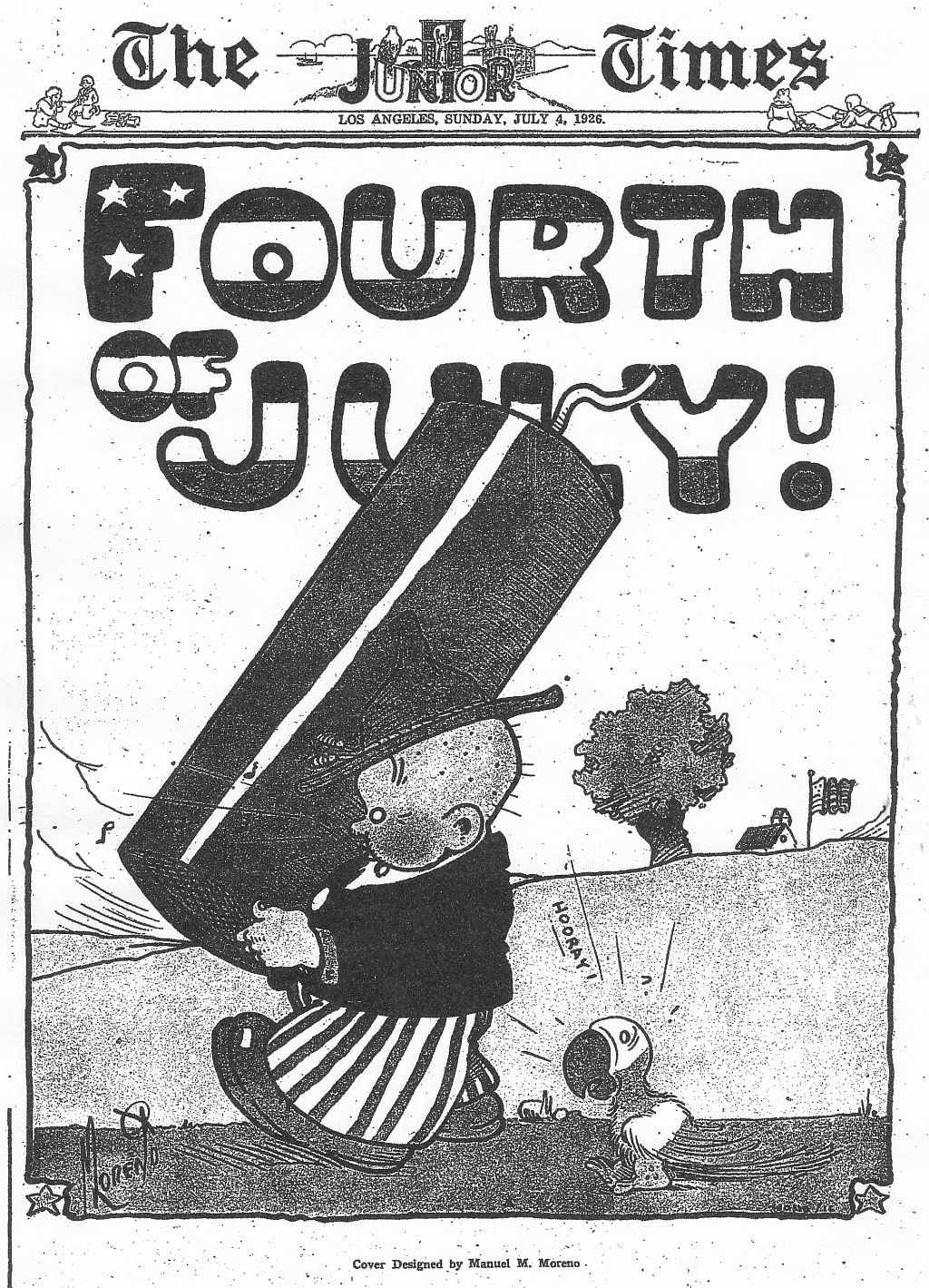








  I’m posting again so soon, because it’s that time of the month. Yowp has posted a new batch of Yogi Bear Sunday pages on his website (link in the blogroll to the left). Therefore, I will contribute my versions at the bottom of this post. At the top, you will find more material from the L.A. Jr. Times, July, 1926. A cover for the July 4th issue by Manuel Moreno and three more “Keen and Feeble Tat” strips, plus a collection of spot gag panels that Manuel contributed as space filler for the Jr. Times. There are two more “Fido Bark” strips by Bob Wickersham, a couple of Fred Moore kid strips and a strip by Frank Tipper called “The Average Home” from 7-26.
 I’m posting again so soon, because it’s that time of the month. Yowp has posted a new batch of Yogi Bear Sunday pages on his website (link in the blogroll to the left). Therefore, I will contribute my versions at the bottom of this post. At the top, you will find more material from the L.A. Jr. Times, July, 1926. A cover for the July 4th issue by Manuel Moreno and three more “Keen and Feeble Tat” strips, plus a collection of spot gag panels that Manuel contributed as space filler for the Jr. Times. There are two more “Fido Bark” strips by Bob Wickersham, a couple of Fred Moore kid strips and a strip by Frank Tipper called “The Average Home” from 7-26.









 Â Here’s Barker Bill, from 5-30 to 6-9-1955. I’ve included the black and white version of the Sunday page we ran last time in color, which proves that the page appeared in 1955, not 1950. Sorry Ger! The “Puddy’s Coronation” story ends on 6-7, as Puddy tries to put his kingdom of Screwbalia on the “Bone Standard” as a monetary value. It nearly causes a revolution, driving Puddy and the Circus back to the States. On 6-8, the story of Newton Mommisboy, reporter, starts as Newton tries to interview a Mermaid who is part of Barker Bill’s circus. On June 5th, the Boston Globe dropped the Barker Bill strip, so the rest of the ones I have come from The Greensburg Daily Tribune, which only ran the daily four days a week. I think we can still tell what’s going on, however, the Greensburg paper’s Google News Archive collection is not as sharp as the ProQuest Boston Globe.
 Here’s Barker Bill, from 5-30 to 6-9-1955. I’ve included the black and white version of the Sunday page we ran last time in color, which proves that the page appeared in 1955, not 1950. Sorry Ger! The “Puddy’s Coronation” story ends on 6-7, as Puddy tries to put his kingdom of Screwbalia on the “Bone Standard” as a monetary value. It nearly causes a revolution, driving Puddy and the Circus back to the States. On 6-8, the story of Newton Mommisboy, reporter, starts as Newton tries to interview a Mermaid who is part of Barker Bill’s circus. On June 5th, the Boston Globe dropped the Barker Bill strip, so the rest of the ones I have come from The Greensburg Daily Tribune, which only ran the daily four days a week. I think we can still tell what’s going on, however, the Greensburg paper’s Google News Archive collection is not as sharp as the ProQuest Boston Globe.





 Â Felix, from 8-5 to 8-11-1935 continues the story of the expedition to the Ape’s Island. Danny is rounded up, and Felix discovers an ancient Chinese jar that’s twenty thousand years old. They sure made jars to last! In the Sunday, Felix cures a man of his superstitious fear of black cats by giving him dreams. I love the design of the black cat that Felix rescues! Pure Messmer magic!
 Felix, from 8-5 to 8-11-1935 continues the story of the expedition to the Ape’s Island. Danny is rounded up, and Felix discovers an ancient Chinese jar that’s twenty thousand years old. They sure made jars to last! In the Sunday, Felix cures a man of his superstitious fear of black cats by giving him dreams. I love the design of the black cat that Felix rescues! Pure Messmer magic!




 Â Krazy, from 6-14 to 6-21-1941, features several strips based on songs that Krazy loves to sing. See if you remember them.
 Krazy, from 6-14 to 6-21-1941, features several strips based on songs that Krazy loves to sing. See if you remember them.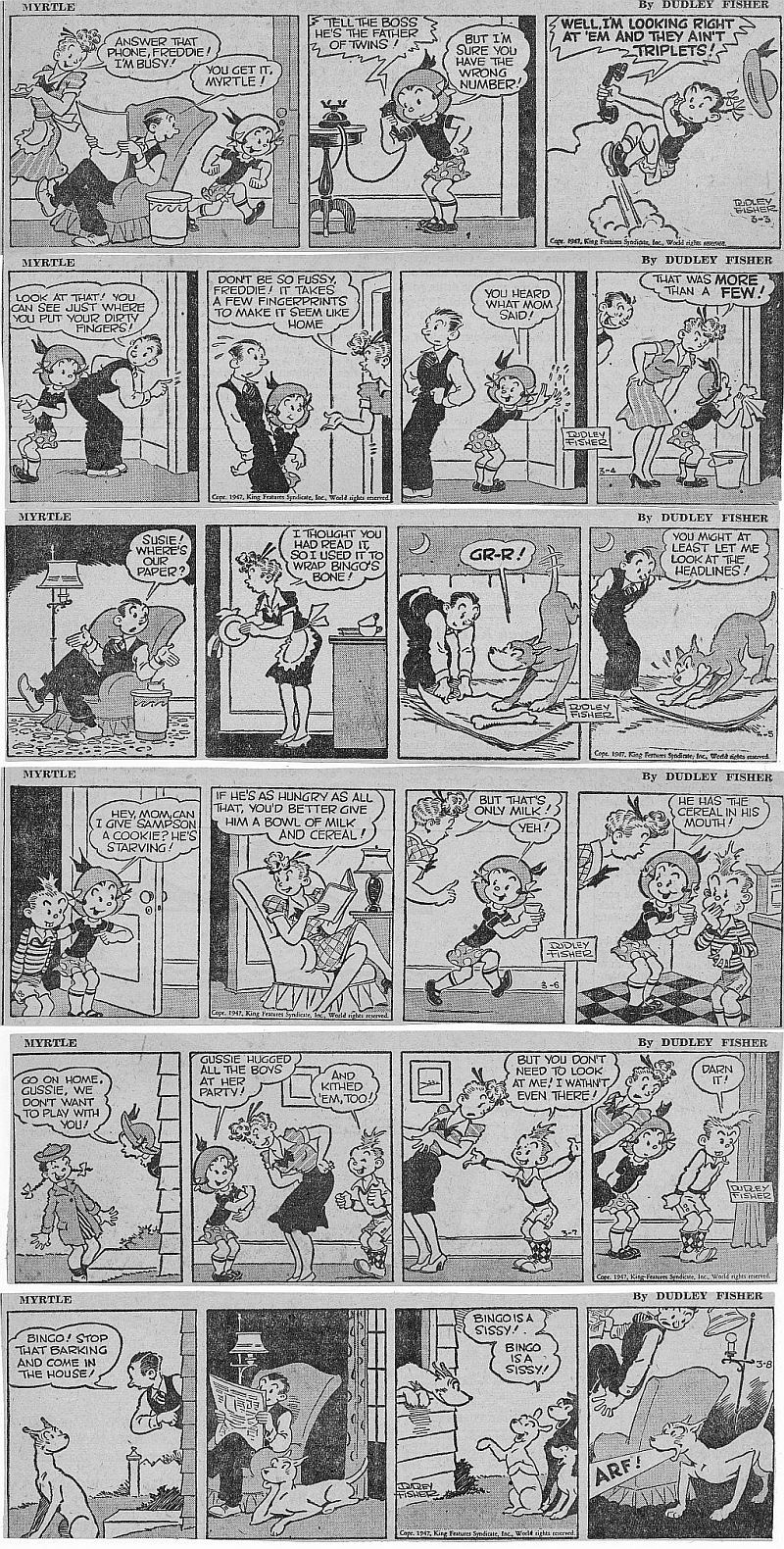  Myrtle is from 3-3 to 3-8-1947. Bingo is featured in the 3-5 and 3-8. Note the human position of Bingo’s right front leg in the 3-8, as he rests his chin on his paw. Dudley Fisher did an effective balancing act of human and canine attitudes in his dog characters, working them on both levels. Occasionally, Myrtle and Sampson can have “conversations” with Bingo and Hyacinth, as you will see.
 Myrtle is from 3-3 to 3-8-1947. Bingo is featured in the 3-5 and 3-8. Note the human position of Bingo’s right front leg in the 3-8, as he rests his chin on his paw. Dudley Fisher did an effective balancing act of human and canine attitudes in his dog characters, working them on both levels. Occasionally, Myrtle and Sampson can have “conversations” with Bingo and Hyacinth, as you will see.


  Now we’ve come to the reason for this post, the color versions of the Yogi Bear Sundays from 6-3 to 6-24-1962. As you see, they are not half-page, but third-page versions. The Bloom was off the Bear by 1962 as far as the St. Louis Post-Dispatch was concerned, and they demoted Yogi by running him as a third-page feature. Yogi eventually switched to the St. Louis Globe-Democrat which restored the half-page Yogi, those will be coming up next time. Yowp has these strips at the half-page size on his latest post, so go over there to read the missing top row of panels. Most of the art on these is by Harvey Eisenberg, and Doggie Daddy (called “Augie Daddy” in the strip) makes a guest shot in the 6-17. Sorry for the haste in slapping this post together, we’ll do better next time.
 Now we’ve come to the reason for this post, the color versions of the Yogi Bear Sundays from 6-3 to 6-24-1962. As you see, they are not half-page, but third-page versions. The Bloom was off the Bear by 1962 as far as the St. Louis Post-Dispatch was concerned, and they demoted Yogi by running him as a third-page feature. Yogi eventually switched to the St. Louis Globe-Democrat which restored the half-page Yogi, those will be coming up next time. Yowp has these strips at the half-page size on his latest post, so go over there to read the missing top row of panels. Most of the art on these is by Harvey Eisenberg, and Doggie Daddy (called “Augie Daddy” in the strip) makes a guest shot in the 6-17. Sorry for the haste in slapping this post together, we’ll do better next time.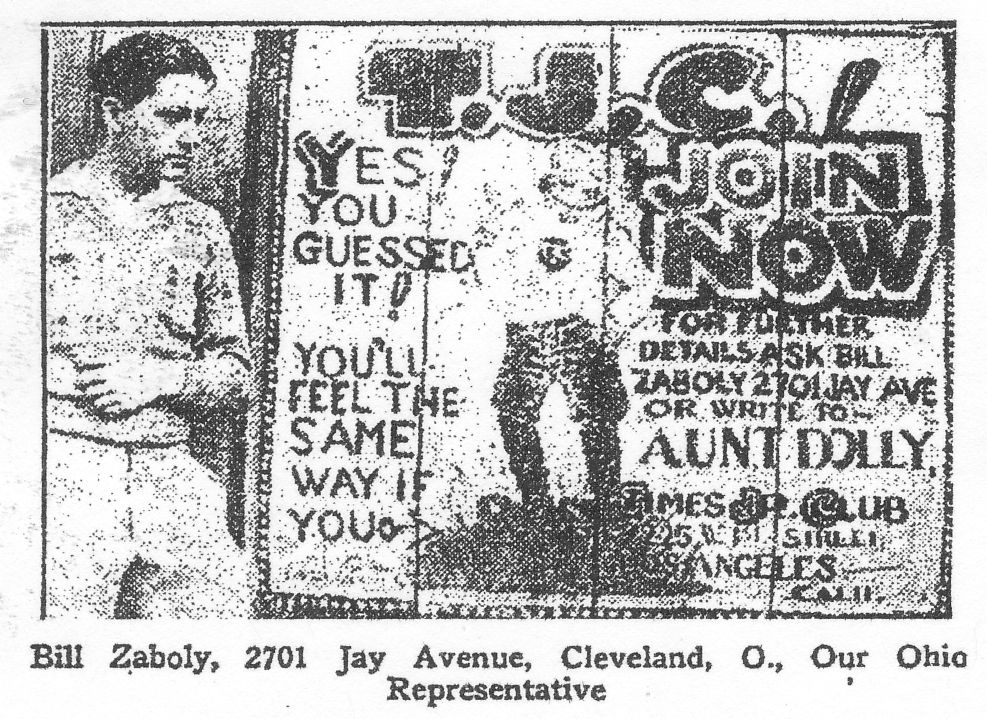


And So Manon, Goodbye
June 29, 2012
Uncategorized
7 Comments
Mark
(In honor of Manon, no comics this post, all the cartoons are illustrations for the article. I have preserved most of Manon’s spelling and punctuation in the excerpts from her letters. Remember to click on the thumbnails to enlarge the pictures.)
You see, Manon was a very special childhood heroine of mine. Her first husband, Everett Washburn was a sheet metal worker who was employed at Curtis-Wright aircraft in California with my Dad Albert in the 1930s. Dad thought a great deal of Everett, they were good friends, and Everett told my dad that his wife was an inker in the animated cartoon business. I wrote to her, telling her of my great love for cartoons and desire to get into the business. Amazingly, she was not discouraging, but decidedly upbeat about it, a great contrast to my Mother’s attitude toward cartoons. We exchanged letters often, and she sent me many inked cels from commercials and TV shows she was working on, this was 1963 to 1967. She went out of her way to find animation artwork for me: Manon writing on March 12, 1964: I am really thrilled with one thing I am sending and am so very lucky to have gotten it. It is a complete story-board layout of one of the half-hour Flintstone shows. (TS-132 “Ladies Night Out At The Lodge”P-109) You yourself are really responsible for my getting it. You see, I have patiently approached one animator after another with your letter and begged for a crumb from their board. Some, as you know, are too busy to take much interest, others are pleased at your interest but don’t come up with anything—-and then there’s that one in a million who really knocks himself out because he has the capacity to appreciate what you are doing. This one I am talking about is an animator, a marvelous one, named Willie Ito (pronounced EETO). He is of Japanese descent I think but a real “way out kid” and what an artist! Well, anyhow, I told Willie about you (he works at Hanna-Barbera) and gave him your letter to read at his leasuire. He was charming and appeared both interested and impressed but I wasn’t sure about it until he handed me a huge folder full of loot!! He enclosed all kinds of production pictures beside the layout but told me he was sure you would get the most out of it because all the camera instructions are given on it and you would see all the terms that they use and how they indicate various things. I went through it carefully and was tempted to interpret such things as FX which means effects (sound, usually) but decided against it because I’m pretty sure you will understand it all without my help. I feel that you have enough background in animation to figure it out without difficulty. Of course, it goes without saying, that someone without your knowledge would not get the camera moves indicated and other strictly animation terms. (Among the drawings were several from the Magilla Gorilla Show main titles)
You yourself are really responsible for my getting it. You see, I have patiently approached one animator after another with your letter and begged for a crumb from their board. Some, as you know, are too busy to take much interest, others are pleased at your interest but don’t come up with anything—-and then there’s that one in a million who really knocks himself out because he has the capacity to appreciate what you are doing. This one I am talking about is an animator, a marvelous one, named Willie Ito (pronounced EETO). He is of Japanese descent I think but a real “way out kid” and what an artist! Well, anyhow, I told Willie about you (he works at Hanna-Barbera) and gave him your letter to read at his leasuire. He was charming and appeared both interested and impressed but I wasn’t sure about it until he handed me a huge folder full of loot!! He enclosed all kinds of production pictures beside the layout but told me he was sure you would get the most out of it because all the camera instructions are given on it and you would see all the terms that they use and how they indicate various things. I went through it carefully and was tempted to interpret such things as FX which means effects (sound, usually) but decided against it because I’m pretty sure you will understand it all without my help. I feel that you have enough background in animation to figure it out without difficulty. Of course, it goes without saying, that someone without your knowledge would not get the camera moves indicated and other strictly animation terms. (Among the drawings were several from the Magilla Gorilla Show main titles)  Do let me know if you are as pleased with it as I was. If you saw this particular Flintstone show, it will have even more meaning than otherwise. I always admired her ability with pen and brush on the unforgiving plastic ice pond known as a cel. She had such a delicate, supple fine line. Look at these examples from a Navy Recruiting spot produced at Playhouse Pictures.
Do let me know if you are as pleased with it as I was. If you saw this particular Flintstone show, it will have even more meaning than otherwise. I always admired her ability with pen and brush on the unforgiving plastic ice pond known as a cel. She had such a delicate, supple fine line. Look at these examples from a Navy Recruiting spot produced at Playhouse Pictures.  I especially like the hands and the cel with the tiny girl: On a visit to her house in 1963, she showed me several old cels from Leon Schlesinger cartoons of 1943. I remember she had one of Bugs Bunny, an early Elmer Fudd, and several others, all in that amazing fine line. She worked on “Hell-Bent For Election” at the fledgling UPA in 1944 when it was Industrial Film and Poster Service. This pro-Roosevelt film was right in line with her politics at the time. Manon worked on this picture with Martha Sigall, famed Schlesinger inker. Manon writing in 1964: It interested me very much when you said that the “great classics and animation were meant for each other”. I have always felt very strongly that as an educational medium, animation would have no equal. During the war (WWII), I worked on training films for the Army Air Force and I have never been able to forget the wonderful way animation can teach. (This was when Manon was with the First Motion Picture Unit in 1943. She’s to the extreme right of the photo-not politically.)
I especially like the hands and the cel with the tiny girl: On a visit to her house in 1963, she showed me several old cels from Leon Schlesinger cartoons of 1943. I remember she had one of Bugs Bunny, an early Elmer Fudd, and several others, all in that amazing fine line. She worked on “Hell-Bent For Election” at the fledgling UPA in 1944 when it was Industrial Film and Poster Service. This pro-Roosevelt film was right in line with her politics at the time. Manon worked on this picture with Martha Sigall, famed Schlesinger inker. Manon writing in 1964: It interested me very much when you said that the “great classics and animation were meant for each other”. I have always felt very strongly that as an educational medium, animation would have no equal. During the war (WWII), I worked on training films for the Army Air Force and I have never been able to forget the wonderful way animation can teach. (This was when Manon was with the First Motion Picture Unit in 1943. She’s to the extreme right of the photo-not politically.) A year or so ago, there was an hour long animated story on the sun on T.V. (“Our Mr. Sun”) It may have been made for a science class. It was expertly done and the (sometimes) dull scientific facts about the sun, its energy and what relation and effect it has on our lives was never more interestingly given. Here’s a few words about animation that Manon wrote in 1962, together with a wage breakdown for animation workers of the day:
A year or so ago, there was an hour long animated story on the sun on T.V. (“Our Mr. Sun”) It may have been made for a science class. It was expertly done and the (sometimes) dull scientific facts about the sun, its energy and what relation and effect it has on our lives was never more interestingly given. Here’s a few words about animation that Manon wrote in 1962, together with a wage breakdown for animation workers of the day:
One of the most intriguing things about animation is the liberty the animator has in interpreting a character (such as Walt Disney did with Mickey Mouse).I work on all the Burgie Beer commercials–he’s a very stylized little man. There’s a tremendous latitude between a drawing that almost is human and one that’s vastly simplified such as the Folger Coffee bean. I see no harm in Mark concentrating on what interests him most, that is animating a figure. There will always be artists who are only interested in drawing backgrounds. Most of the top people in the animation field have had four years of art school—not as many have had college art training because it usually isn’t as good. U.C.L.A. is, and there he would get the well-rounded education that is necessary in almost every intelligent field today. The top animators become storyboard layout men and for that you need a comprehensive education, psychology, philosophy, history, etc.
I see no harm in Mark concentrating on what interests him most, that is animating a figure. There will always be artists who are only interested in drawing backgrounds. Most of the top people in the animation field have had four years of art school—not as many have had college art training because it usually isn’t as good. U.C.L.A. is, and there he would get the well-rounded education that is necessary in almost every intelligent field today. The top animators become storyboard layout men and for that you need a comprehensive education, psychology, philosophy, history, etc.
The animation field is not too crowded. Highest in demand are the story-board and layout men. Each studio has only a few. Their weekly check is in the neighborhood of $500 a week. The top animators and background artists get between $250 (min.) and $450–etc. Assistant animators (just off the art school assembly line–) begin at $200 a week. Anim. Checkers make $150. Inkers, like myself, make $105. (take home $86) and painters make $90.
Despite the relatively low wages she earned, Manon was a hard worker and often took on two or three jobs at the same time to earn extra money.
Manon writing in August 1967: The Cartoon industry is still flourishing out here! Inkers are still at a premium. For almost two years now. I have been able to make more than a fourty hour check by simply taking work from more than one studio. Everything is still on the up-swing. New contracts and commercials, new animated series are all still very much with us. After I finished Charlie Brown All Stars for Bill Melendez, I went to work for Grant-Ray Lawrence who are putting out a series called Marvel Super Hero’s and out here it is on Sun. eves at 6pm for half an hour. It is limited animation and inking is just a matter of mouths, eyes, arms moving and loads of special effects! (guns blasting-rays-explosions, bullets conecting-etc.–it’s wild!)
Just last week, I also got some work from my favorite employer, Mary Cain, who you met. Disney is so busy with live action and other things–that he farmed out a commercial to Mary—So at last! I can say I have worked for Disney! I was careful to ink several of the cutest characters for you and I will paint them up and send them along! And you can say that Disney had to get his old animators to draw them, as the youngsters didn’t know how! It’s the real thing! Revived!
She did this overtime and free-lance practically all through her working life. Here, Manon gave me an idea of just how busy she could get: …my studio kept me very busy all through December. You should see me inking at my desk while the (neighbor’s) children build with the blocks on the rug beside me. If one knocks the other over the head with a block, Cathy (Manon’s daughter) dashes in to referee while I glance over occasionally to make sure blood isn’t flowing freely yet! As you can see from these sample cels, Manon could work with a wide variety of line styles, thick, thin, brush, pen or grease pencil.



….I am sending some long cels in hopes you can cut them to size. They were rejections on “Mad, Mad World” because of scratches. I don’t think scratches show up on ordinary pictures, it was just that each cel was blown up ten feet and every speck of dust came through on the film. Also, I am sending some actual rejected sequences on “Mad World”. This is somewhat against my better judgement because you may find it worthless. I had to do the scene completely over because of scratches and I thought that either you would be interested in seeing the animation or that you could wash the cels off and re-use them. Let me know later on if you found any use for them. I’m still using them, Manon:

I visited the Washburns on my own in the summer of 1968, on vacation from Art School in Kansas City, intending to stay for two weeks. By the time I got out to Los Angeles, Everett and Manon were no longer married, but Everett lived about four blocks away from where Manon lived in Tujunga, so he put me up in a shed at the back of his house. I’ll never forget the first few nights I tried to sleep out there, so excited about cartoons and being so near to where they are made that I couldn’t close my eyes! While staying at Everett’s house, he taught me about Karl Marx and especially Marx’s predecessor, Georg Hegel. Everett was quite a serious, scholarly man who had very deep political beliefs. I got the feeling that Manon and Everett might have been attracted to each other partially from their political sensibilities. Manon could be a firebrand, being quite a critic of the war in Vietnam. She was in great favor of peace, we had quite a few discussions about that.
Manon made it possible for me to have a job, then a career in animated cartooning! She introduced me to Gary Mooney, who was animating a Green Giant commercial at Quartet Studio. He let me do a few inbetweens of the elves in the spot. They were no great beauties, but they were inkable. Here’s one of Gary’s roughs from that spot: I took the drawings into Filmation as samples; Hal Sutherland looked them over and said two words: “Start Monday”. I couldn’t drive, so I learned the bus route from Tujunga (where Manon lived) to Sherman Way in Reseda where Filmation was. I was in cartoon heaven working there, and met many old timers like Ruben Timmens and Virgil Ross. At last I wore out my welcome at Everett’s house (didn’t know enough about Hegel), and wound up bunking in the editing room of Fred Calvert’s studio in North Hollywood, which was a shorter bus ride to Filmation. I found myself working days at Filmation and nights at Fred Calvert’s, to earn my room. I would have worked 24 hours a day if I hadn’t needed sleep, I was just so excited to be doing professional work! I met Duane Crowther at Calvert’s, who became another mentor and great friend to me. All this happened because Manon introduced me to Gary Mooney.
I took the drawings into Filmation as samples; Hal Sutherland looked them over and said two words: “Start Monday”. I couldn’t drive, so I learned the bus route from Tujunga (where Manon lived) to Sherman Way in Reseda where Filmation was. I was in cartoon heaven working there, and met many old timers like Ruben Timmens and Virgil Ross. At last I wore out my welcome at Everett’s house (didn’t know enough about Hegel), and wound up bunking in the editing room of Fred Calvert’s studio in North Hollywood, which was a shorter bus ride to Filmation. I found myself working days at Filmation and nights at Fred Calvert’s, to earn my room. I would have worked 24 hours a day if I hadn’t needed sleep, I was just so excited to be doing professional work! I met Duane Crowther at Calvert’s, who became another mentor and great friend to me. All this happened because Manon introduced me to Gary Mooney.
I remember getting a lot of life lessons from Manon. I was pretty annoying and geeky when I got out to Los Angeles, (still am occasionally) and talked about cartoons almost all the time. Manon put up with it for quite awhile, but she eventually lost patience with my cartoon yammering. She let me know that even though she had been in the business since 1943, she didn’t really care for cartoons all that much. She was an artist, that happened to have the skill to work as an inker. She enjoyed the work to an extent, but it wasn’t a calling. (Later on, Manon taught watercolor painting, just look at her flowers and landscapes.)
 I don’t think Manon ever told me exactly how she got started in the business, she was probably close to 21 when she started working. She also taught me to respect her as a lady, to open doors for her, and treat her gently. Not that I was rough on her, but I guess I thought of Manon as a fellow cartoon geek. I got wised up eventually.
I don’t think Manon ever told me exactly how she got started in the business, she was probably close to 21 when she started working. She also taught me to respect her as a lady, to open doors for her, and treat her gently. Not that I was rough on her, but I guess I thought of Manon as a fellow cartoon geek. I got wised up eventually.
Some years later, about 1972, I picked up a job from my friend Joe Adamson. He needed an animator to do a few scenes of Bugs Bunny for his independent short film, “A Political Cartoon”. I actually got a few lessons on how to draw Bugs from his best designer, Bob McKimson. When the drawings were finished, I immediately thought of Manon, who agreed to ink them. What a thrill to have an actual Warner Bros. inker doing my rabbits! I paid her as well as I could, and wound up with no money for the background painter, so I did them myself. I tried to save money on paint by using an old jar of Cartoon Colour rewettable white paint, which cracked and chipped in only a few years. This made the cels actually look much older than they actually were. That and Manon’s artistry made them more saleable as collectibles later on.
One of Manon’s good friends at Bill Melendez Studio was Bernard Gruver, a key layout and story board artist. Bernard thought the world of Manon, and often told me that her life stood for love, and she had a loving attitude to just about everybody. Here’s a birthday card that Bernard drew for Manon:
Manon writing on May 15, 1966: Now about things here in Hollywood. Bill Melendez broke with Playhouse Pix and went into business for himself. No, I did not work on the Charlie Brown Christmas Show, but I did see it. And I have worked on the new baseball show which has just gone to camera. It is called “Charlie Brown All Stars”, its about baseball and airs on June 8th. Please see it in color, if you can, you can’t really appreciate it in black and white. (1/2 hour show -full animation)
You will notice that the smaller studios (like Bill’s) always use inkers because on a small production the quality is more noticeable and more important. (An inker can interpret a character and impart a certain flavor.) The big studios are the only ones using Xerox that I know of–Disney–to be specific. Hanna Barbera are using a sort of grease pencil which goes faster than pen and is adequate for their multiple productions. I have worked on some Xerox for some pretty terrible (my opinion) low budget stuff. Inkers have to repair and register all Xerox. Without exception, all the commercials and shows which I have worked on have been inked. This year everything I have done has been in color. Animation comes across beautifully on color television and so much is being done in color now. Personally, I feel more full of hope than ever for animation and its marvelous possibilities for education, in spite of the poor material that has used this (our) medium thus far. I can’t help believing that not only will someone come along and do marvelous, top quality things in animation, but, that as a medium for education it will be fully utilized. Just because Disney has done so much with animation doesn’t mean he has exhausted the possibilities. (It’s interesting that color television was still such a remarkable novelty in 1966.)
Work is plentiful this year and the future looks bright.
Here are a few words that Manon wrote about the automation of the inking process (Xerox) which still ring true in the computer era: I fully agree with all you said on automation. In some places Xerox is replacing inkers but I cannot possibly imagine how it could replace animators. When that day comes and individual creative effort is eliminated it will be a sad commentary on the human race. Let’s have faith that we will never do that to ourselves. I do think that in many places in the world, people are not as barbaric as they used to be. But our scientific development is still way ahead of our social development. The great animator Grim Natwick came to nearly the same conclusion about scientific and social development when he was thinking about computer animation and electronic gadgets years later.
I had the great honor to speak for Manon in 2005, when she got her Golden Award for a lifetime in animation. Manon’s family, my wife Cathy and I were all there around her table at the Golden Awards banquet.  It was such a great night. It was an honor to see one of the good people, the inkers who never got enough credit for making animation drawings look good on the screen, receive this honor from her peers.
In her last years, I saw Manon less frequently. Her family expanded and she became a great-grandmother. Just look at that happy face with her grand-child Cove in 2011. That’s the way I like to remember Manon, that beaming happiness. All her children have that warm smile, it’s a family trademark. Her son, Conrad certainly has the family smile:
That’s the way I like to remember Manon, that beaming happiness. All her children have that warm smile, it’s a family trademark. Her son, Conrad certainly has the family smile:  I learned to respect Manon’s look of seriousness too, it meant she was thinking, and most of her thoughts were worth listening to. Her voice was breathy when she talked, almost a Marilyn Monroe inflection, but not as caricatured. She made friends easily, and never forgot a friend. Manon, I hope you will never be forgotten by your friends. Carla tells me that her Mom was alert, happy, teaching watercolor, dancing and active right up to the very end. Thanks, dear lady for all that you did for me. And so, Manon, Goodbye.
I learned to respect Manon’s look of seriousness too, it meant she was thinking, and most of her thoughts were worth listening to. Her voice was breathy when she talked, almost a Marilyn Monroe inflection, but not as caricatured. She made friends easily, and never forgot a friend. Manon, I hope you will never be forgotten by your friends. Carla tells me that her Mom was alert, happy, teaching watercolor, dancing and active right up to the very end. Thanks, dear lady for all that you did for me. And so, Manon, Goodbye.
(Any comments on Manon would be welcomed by her family. You can reach them at: yiayia.washburn@gmail.com . You are also welcome to comment here.)